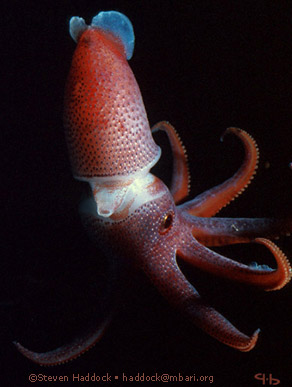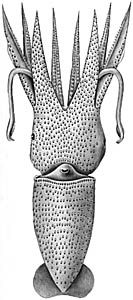Histioteuthis heteropsis
Richard E. Young and Michael VecchioneIntroduction
H. heteropsis is similar to its closest relative, H. meleagroteuthis, in the uniform, dense pattern of complex photophores on the head, arms IV and the mantle but lacks tubercules. This species is common off the coast of Southern California (USA) and has been observed from submersibles many times. It is lethargic in response to disturbance by an ROV; movements are slow and deliberate, even when jetting, inking is rarely observed (Hunt, 1966). The geographical distribution is unusual in that two separate populations exist one in the North Pacific and one in the South Pacific (antitropical distribution). It is found in temperate regions on the eastern side of the Pacific. Off southern California it occupies mesopelagic depths during the day and migrates vertically at night, presumably to feed. Maximum recorded size is 132 mm ML (Voss, et al., 1998).
Characteristics
- Tubercles
- Absent
Comments
More details of the description can be found here.Species of the meleagroteuthis-group are distinguished by the following characteristics:
- Photophores
- In 8-10 series on arm IV base.
- Usually 19-22 photophores on right eyelid.
- Compound photophores of uniform size, small and densely packed on anterior 3/4 of ventral mantle.
H. heteropsis is easily separated from its closest relative, H. meleagroteuthis, by the absence of tubercles.
The above information is taken from Voss (1969) and Voss, et al. (1998).
Nomenclature
The holotype (by subsequent designation) is no longer extant. The single paratype, a female, exists at the California Academy of Sciences, San Francisco (Sweeney et al., 1988).
Life History
Males mature between 54-89 mm ML; size of maturity of females is unknown (Voss et al., 1998). Paralarvae (i.e., pre-photophore stage) have not been described.
Distribution
Vertical distribution
These data from a vertical distribution study off Southern California shows that H. heteropsis migrates vertically from over 400 m during the day into the upper 400 m at night (Roper and Young, 1975.).
 image info
image info Figure. Chart of the vertical distribution of H. heteropsis, California waters. Captures were made with open 3-m trawls. Blue color - Night captures. Yellow color - Day captures. Lighter hues - Correction factor to adjust for unequal trawling time at each depth. Chart modified from Roper and Young (1975).
Geographical distribution
Type locality: Eastern North Pacific, off Santa Barbara Island. H. heteropsis is common in the California Current system between 24° and 45° N. It is also common in the Peru-Chile Current system between 30° and 36° S. In tropical waters it is generally replaced by its close relative, H. meleagroteuthis, although a single record (00° 38'S, 89° 29'W) is known from equatorial waters (Voss, et al., 1998).
Figure. Chart of the geographical distribution of H. heteropsis. Modified from Voss et al. (1998).
References
Roper, C. F. E. and R. E. Young. 1975. Vertical distribution of pelagic cephalopods. Smithsonian Contributions to Zoology, 209: 1-51.
Voss, N. A. 1969. A monograph of the Cephalopoda of the North Atlantic: The family Histioteuthidae. Bull. Mar. Sci., 19: 713-867.
Voss, N.A., K. N. Nesis, P. G. Rodhouse. 1998. The cephalopod family Histioteuthidae (Oegopsida): Systematics, biology, and biogeography. Smithson. Contr. Zool., 586(2): 293-372.
Young, R. E. 1972. The systematics and areal distribution of pelagic cephalopods from the seas off Southern California. Smithson. Contr. Zool., 97: 1-159.
Title Illustrations
| Scientific Name | Histioteuthis heteropsis |
|---|---|
| Location | Off California |
| Comments | Photographed insitu from the Monterey Bay Aquarium Research Institute ROV |
| Acknowledgements | Photograph first appeared at http://lifesci.ucsb.edu/~biolum/ |
| Specimen Condition | Live Specimen |
| Copyright | © 2000 Steven Haddock |
About This Page
Richard E. Young
Dept of Oceanography
University of Hawaii
Honolulu, Hawaii 96822
USA
National Marine Fisheries Service
Systematics Laboratory
National Museum of Natural History
Washington, D. C. 20560
USA
Page copyright © 2000 Richard E. Young and
Citing this page:
Young, Richard E. and Vecchione, Michael. 2000. Histioteuthis heteropsis . Version 01 January 2000 (under construction). http://tolweb.org/Histioteuthis_heteropsis/19809/2000.01.01 in The Tree of Life Web Project, http://tolweb.org/










